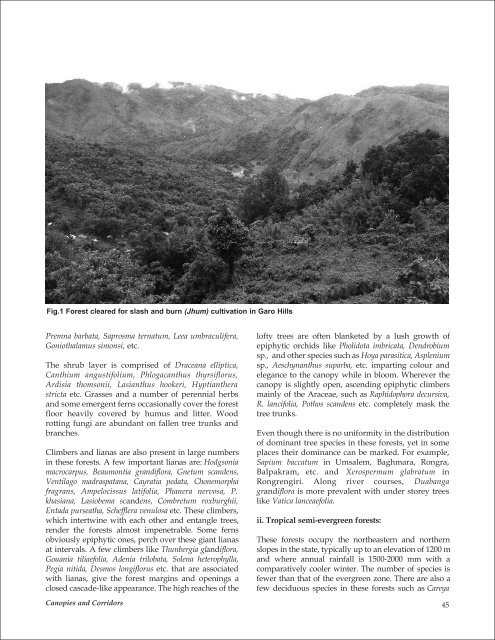Canopies and Corridors - International Fund for Animal Welfare
Canopies and Corridors - International Fund for Animal Welfare
Canopies and Corridors - International Fund for Animal Welfare
Create successful ePaper yourself
Turn your PDF publications into a flip-book with our unique Google optimized e-Paper software.
Fig.1 Forest cleared <strong>for</strong> slash <strong>and</strong> burn (Jhum) cultivation in Garo Hills<br />
Premna barbata, Saprosma ternatum, Leea umbraculifera,<br />
Goniothalamus simonsi, etc.<br />
The shrub layer is comprised of Draceana elliptica,<br />
Canthium angustifolium, Phlogacanthus thyrsiflorus,<br />
Ardisia thomsonii, Lasianthus hookeri, Hyptianthera<br />
stricta etc. Grasses <strong>and</strong> a number of perennial herbs<br />
<strong>and</strong> some emergent ferns occasionally cover the <strong>for</strong>est<br />
floor heavily covered by humus <strong>and</strong> litter. Wood<br />
rotting fungi are abundant on fallen tree trunks <strong>and</strong><br />
branches.<br />
Climbers <strong>and</strong> lianas are also present in large numbers<br />
in these <strong>for</strong>ests. A few important lianas are: Hodgsonia<br />
macrocarpus, Beaumontia gr<strong>and</strong>iflora, Gnetum sc<strong>and</strong>ens,<br />
Ventilago madraspatana, Cayratia pedata, Chonemorpha<br />
fragrans, Ampelocissus latifolia, Phanera nervosa, P.<br />
khasiana, Lasiobema sc<strong>and</strong>ens, Combretum roxburghii,<br />
Entada purseatha, Schefflera venulosa etc. These climbers,<br />
which intertwine with each other <strong>and</strong> entangle trees,<br />
render the <strong>for</strong>ests almost impenetrable. Some ferns<br />
obviously epiphytic ones, perch over these giant lianas<br />
at intervals. A few climbers like Thunbergia gl<strong>and</strong>iflora,<br />
Gouania tiliaefolia, Adenia trilobata, Solena heterophylla,<br />
Pegia nitida, Desmos longiflorus etc. that are associated<br />
with lianas, give the <strong>for</strong>est margins <strong>and</strong> openings a<br />
closed cascade-like appearance. The high reaches of the<br />
<strong>Canopies</strong> <strong>and</strong> <strong>Corridors</strong><br />
lofty trees are often blanketed by a lush growth of<br />
epiphytic orchids like Pholidota imbricata, Dendrobium<br />
sp., <strong>and</strong> other species such as Hoya parasitica, Asplenium<br />
sp., Aeschynanthus suparba, etc. imparting colour <strong>and</strong><br />
elegance to the canopy while in bloom. Wherever the<br />
canopy is slightly open, ascending epiphytic climbers<br />
mainly of the Araceae, such as Raphidophora decursiva,<br />
R. lancifolia, Pothos sc<strong>and</strong>ens etc. completely mask the<br />
tree trunks.<br />
Even though there is no uni<strong>for</strong>mity in the distribution<br />
of dominant tree species in these <strong>for</strong>ests, yet in some<br />
places their dominance can be marked. For example,<br />
Sapium baccatum in Umsalem, Baghmara, Rongra,<br />
Balpakram, etc. <strong>and</strong> Xerospermum glabratum in<br />
Rongrengiri. Along river courses, Duabanga<br />
gr<strong>and</strong>iflora is more prevalent with under storey trees<br />
like Vatica lanceaefolia.<br />
ii. Tropical semi-evergreen <strong>for</strong>ests:<br />
These <strong>for</strong>ests occupy the northeastern <strong>and</strong> northern<br />
slopes in the state, typically up to an elevation of 1200 m<br />
<strong>and</strong> where annual rainfall is 1500-2000 mm with a<br />
comparatively cooler winter. The number of species is<br />
fewer than that of the evergreen zone. There are also a<br />
few deciduous species in these <strong>for</strong>ests such as Careya<br />
45

















